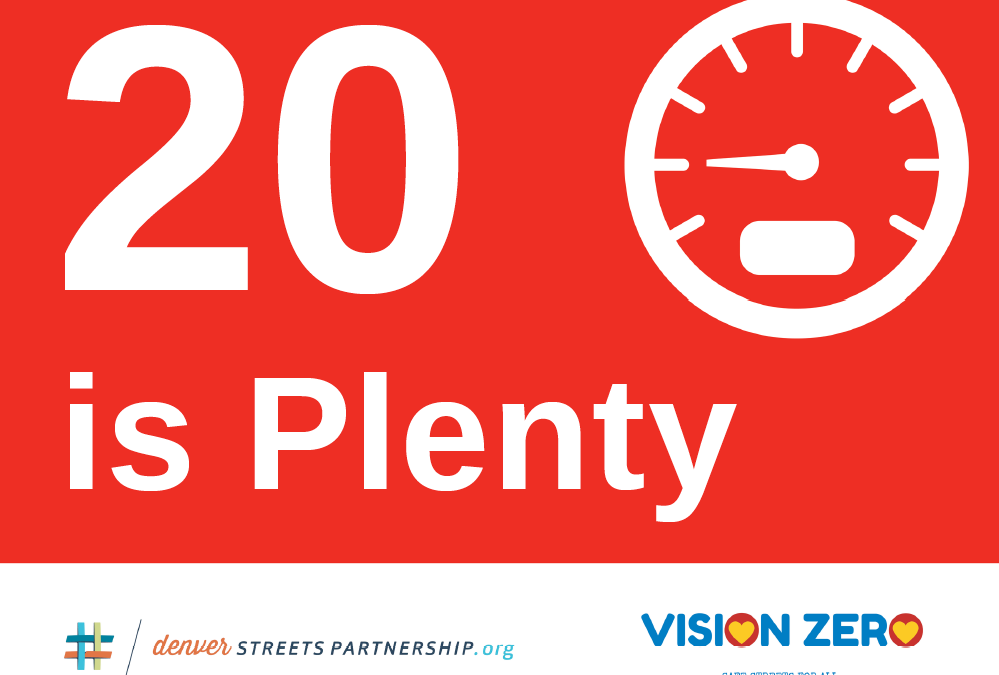The following remarks were delivered by Jill Locantore, Executive Director of the Denver Streets Partnership, on Wednesday, December 1, 2021, at Denver City Council’s Safety, Housing, Education & Homelessness Committee.
Good morning, I am Jill Locantore, Executive Director of the Denver Streets Partnership. The Denver Streets Partnership is a coalition of community groups advocating for people-friendly streets. On behalf of the coalition, I strongly urge you to move forward with the proposed ordinance reducing the default speed limit on city streets.
As of today, 77 people have been killed in preventable crashes on Denver’s streets in 2021, the highest since our City first declared its commitment to Vision Zero in 2016. Speed is a factor in many traffic deaths. We have the data. The faster a car is moving, the less time the driver has to see a pedestrian and slow down or stop and the higher the injury risk for the pedestrian. Even small increases in vehicle speed can have fatal results. A pedestrian has a 13% likelihood of a severe injury or fatality if struck by a vehicle traveling 20 mph. That chance jumps to 40% if the vehicle is going 30 mph. To reverse this alarming trend of increasing traffic deaths in Denver, the City must use all of the tools available. Reducing the default speed limit is a simple action that Council can take that will immediately improve safety on our streets.
We know that speed is one of the most important factors that determines whether a crash happens, and whether the crash results in a serious injury or fatality. We know that street design is ultimately the best way to reinforce safe speeds. And we know that speed limits are important too. For example, when the City of Seattle recently reduced speed limits, they only modified signage without any communications campaign, signal retiming, increased enforcement, or engineering adjustments, and saw a decrease both in speeding and in serious crashes.
Lower speed limits not only make our streets safer, they also make our streets more livable.
On neighborhood streets, where the default speed limit primarily applies, people should feel safe walking their dog, playing with kids in their front yard, gardening in the planting strip, walking to get groceries, biking with their kids to school, or just gathering with their neighbors. Lower speed limits are a statement of our City’s values, that we value the safety and livability of our neighborhoods over the speed and convenience of driving.
Importantly, the Denver Streets Partnership does not believe that lower speed limits should be used as justification for increased traffic enforcement, and particularly officer-initiated enforcement. Lower speed limits should be used to justify street design changes such as speed humps, mini traffic circles, and chicanes, so that streets become “self-enforcing.”
This approach is consistent with the recommendation from the Task Force to Reimagine Policing and Public Safety to “eliminate the need for traffic enforcement by auditing and investing in the built environment to promote safe travel behavior.”
The widespread support for lower speed limits is evidenced by the thousands of residents from every City Council district who have requested “20 is Plenty” and “Slow the Funk Down” yard signs to display on their street.
We sincerely hope that Council will respond to this groundswell of community support, and the urgent need to address the public health crisis of traffic violence on our streets, by doing your part to bring our City closer to achieving the Vision Zero goal of eliminating traffic fatalities and serious injuries. Thank you for your consideration.

